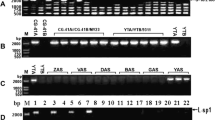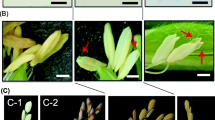Abstract
Key message
Thirteen rice CMS lines derived from different cytoplasms were classified into eight groups by PCR amplification on mtDNA. The orf79 gene, which causes Boro II CMS, possibly results in Dian1-CMS.
Abstract
Thirteen rice cytoplasmic male sterile (CMS) lines derived from different cytoplasms are widely used for hybrid rice breeding. Based on 27 loci on mitochondrial DNA, including single nucleotide polymorphisms and segmental sequence variations between typical indica and japonica as well as high-polymorphism segmental sequence variations and single nucleotide polymorphisms among rice CMS lines, the 13 rice CMS lines were classified into eight groups: (I) wild-abortive CMS, Indonesian Shuitiangu CMS, K-CMS, Gang CMS, D-CMS and dwarf abortive CMS; (II) Maxie-CMS; (III) Honglian CMS; (IV) Boro II CMS; (V) Dian1-CMS; (VI) Liao-CMS; (VII) Lead CMS; and (VIII) Chinese wild rice CMS. According to their pollen abortion phenotypes, groups I and II (including 7 CMS lines) were classified as sporophytic CMS lines, the cytoplasmic genetic relationships among which were very close. They could have originated from similar, or even the same, cytoplasm donors. Groups III–VIII (including 6 CMS lines) were categorized as gametophytic CMS lines, the cytoplasms of which differed from one another, with some having relatively far genetic relationships. Dian1-CMS was found to harbor the orf79 gene, which causes Boro II CMS, whereas Liao-CMS had an orf79 structure that does not result in Lead CMS. Therefore, we speculated that orf79 is associated with Dian1-CMS but not with Liao-CMS. The atp6–orf79 structure related to sterility was also found to experience multiple evolutionary turnovers. All sporophytic CMS lines were indica-like. Except the Honglian CMS line, which was indica-like, all gametophytic CMS lines were japonica-like.


Similar content being viewed by others
Abbreviations
- mtDNA:
-
Mitochondrial DNA
- SSV:
-
Segmental sequence variation
- SNP:
-
Single nucleotide polymorphism
- CMS:
-
Cytoplasmic male sterility
- WA:
-
Wild abortive
- IA:
-
Indonesian Shuitiangu
- GA:
-
Gang
- DA:
-
Dwarf abortive
- HL:
-
Honglian
- BT:
-
Boro II
- CW:
-
Chinese wild
- LD:
-
Lead
- CWR:
-
Common wild rice
References
Ahmadikhah A, Karlov G (2006) Molecular mapping of the fertility-restoration gene Rf4 for WA-cytoplasmic male sterility in rice. Plant Breed 125(4):363–367
Chase CD (2007) Cytoplasmic male sterility: a window to the world of plant mitochondrial-nuclear interactions. Trends Genet 23(2):81–90
Das S, Sen S, Chakraborty A, Chakraborti P, Maiti MK, Basu A, Basu D, Sen SK (2010) An unedited 1.1 kb mitochondrial orfB gene transcript in the wild abortive cytoplasmic male sterility (WA-CMS) system of Oryza sativa L. subsp. indica. BMC Plant Biol 10:39
Deng H (2008) Three lines hybrid japonica rice breeding. In: Deng H, Hua Z, Yang F (eds) Japonica hybrid rice in China. China Agriculture Press, Beijing, pp 243–271 (in Chinese)
Fujii S, Toriyama K (2005) Molecular mapping of the fertility restorer gene for ms-CW-type cytoplasmic male sterility of rice. Theor Appl Genet 111(4):696–701
Fujii S, Toriyama K (2009) Suppressed expression of Retrograde-Regulated Male Sterility restores pollen fertility in cytoplasmic male sterile rice plants. Proc Natl Acad Sci USA 106(23):9513–9518
Fujii S, Kazama T, Yamada M, Toriyama K (2010a) Discovery of global genomic re-organization based on comparison of two newly sequenced rice mitochondrial genomes with cytoplasmic male sterility-related genes. BMC Genomics 11:209
Fujii S, Yamada M, Fujita M, Itabashi E, Hamada K, Yano K, Kurata N, Toriyama K (2010b) Cytoplasmic-nuclear genomic barriers in rice pollen development revealed by comparison of global gene expression profiles among five independent cytoplasmic male sterile lines. Plant Cell Physiol 51(4):610–620
Huang Q, He Y, Jing R, Zhu R, Zhu Y (2000) Mapping of the nuclear fertility restorer gene for HL cytoplasmic male sterility in rice using microsatellite markers. Chin Sci Bull 45(5):430–432
Itabashi E, Kazama T, Toriyama K (2009) Characterization of cytoplasmic male sterility of rice with Lead Rice cytoplasm in comparison with that with Chinsurah Boro II cytoplasm. Plant Cell Rep 28(2):233–239
Jing R, Li X, Yi P, Zhu Y (2001) Mapping fertility-restoring genes of rice WA cytoplasmic male sterility using SSLP markers. Bot Bull Acad Sin 42(3):167–171
Katsuo K, Mizushima U (1958) Studies on the cytoplasmic difference among rice varieties, Oryza sativa L. Jpn J Breed 8:1–5
Li S, Yang D, Zhu Y (2007) Characterization and use of male sterility in hybrid rice breeding. J Integr Plant Biol 49(6):791–804
Lin SC, Yuan LP (1980) Hybrid rice breeding in China. In: Innovative approaches to rice breeding. IRRI, Manila, Philippines, pp 31–51
Liu XQ, Xu X, Tan YP, Li SQ, Hu J, Huang JY, Yang DC, Li YS, Zhu YG (2004) Inheritance and molecular mapping of two fertility-restoring loci for Honglian gametophytic cytoplasmic male sterility in rice (Oryza sativa L.). Mol Genet Genomics 271(5):586–594
Notsu Y, Masood S, Nishikawa T, Kubo N, Akiduki G, Nakazono M, Hirai A, Kadowaki K (2002) The complete sequence of the rice (Oryza sativa L.) mitochondrial genome: frequent DNA sequence acquisition and loss during the evolution of flowering plants. Mol Genet Genomics 268(4):434–445
Peng X, Li F, Li S, Zhu Y (2009) Expression of a mitochondrial gene orfH79 from the CMS-HongLian rice inhibits Saccharomyces cerevisiae growth and causes excessive ROS accumulation and decrease in ATP. Biotechnol Lett 31(3):409–414
Peng X, Wang K, Hu C, Zhu Y, Wang T, Yang J, Tong J, Li S (2010) The mitochondrial gene orfH79 plays a critical role in impairing both male gametophyte development and root growth in CMS-Honglian rice. BMC Plant Biol 10:125
Rao YS (1988) Cytohistology of cytoplasmic male sterile lines in hybrid rice. In: Smith WH, Bostian LR, Cervantes EP (eds) hybrid rice. International Rice Research Institute, Manila, pp 115–128
Rogers SO, Bendich AJ (1985) Extraction of DNA from milligram amounts of fresh, herbarium and mummified plant tissues. Plant Mol Biol 5(2):69–76
Rohlf FJ (1992) NTSYS-pc: numerical taxonomy and multivariate analysis system, version 1.8. Exter Software, New York
Shinjyo C (1969) Cytoplasmic genetic male sterility in cultivated rice, Oryza sativa L. II. The inheritance of male sterility. Jpn J Genet 44(3):149–156
Tan X, Tan Y, Zhao Y, Zhang X, Hong R, Jin S, Liu X, Huang D (2004) Identification of the Rf gene conferring fertility restoration of the CMS Dian-type 1 in rice by using simple sequence repeat markers and advanced inbred lines of restorer and maintainer. Plant Breed 123(4):338–341
Tian X, Zheng J, Hu S, Yu J (2006) The rice mitochondrial genomes and their variations. Plant Physiol 140(2):401–410
Wang Z, Zou Y, Li X, Zhang Q, Chen L, Wu H, Su D, Chen Y, Guo J, Luo D, Long Y, Zhong Y, Liu YG (2006) Cytoplasmic male sterility of rice with boro II cytoplasm is caused by a cytotoxic peptide and is restored by two related PPR motif genes via distinct modes of mRNA silencing. Plant Cell 18(3):676–687
Watanabe Y (1971) Establishment of cytoplasmic and genetic male-sterile lines by means of Indica-Japonica cross. Oryza Cuttack 8(Suppl 2):9–16
Yap I, Nelson R (1996) WINBOOT: a program for performing bootstrap analysis of binary data to determine the confidence limits of UPGMA-based dendrograms. International Rice Research Institute (IRRI) Discussion Paper Series No 14:1–22
Zeng Q, Zhou K, Zhu Z, Luo Q (2000) Current status in the use of hybrid rice heterosis in China. Chin J Rice Sci 14(4):243–246 (in Chinese)
Zhang G, Lu Y, Bharaj T, Virmani S, Huang N (1997) Mapping of the Rf-3 nuclear fertility-restoring gene for WA cytoplasmic male sterility in rice using RAPD and RFLP markers. Theor Appl Genet 94(1):27–33
Zhu Y, Yu J, Xu S, Mei Q, Yang D, Fu B, Huang P, Zhang X (1993) Studies on MaxieA of Maweizhan CMS in native rice variety of China. J Wuhan Univ 6:110–115 (in Chinese)
Acknowledgments
The authors thank Yuanzhu Yang (Hunan Yahua Seed Institute, Changsha, China), Zetian Hua (China National Hybrid Rice Engineering Technology Center, Tianjin Center), Yangsheng Li (College of Life Science, Wuhan University, Wuhan, China), Lifang Hong (Biological Center, Beijing Agricultural Science Academy, Beijing, China), Xuelin Tan (Yunnan Agricultural University, Kunming, China), Qiang Lin (Rice Institute, Fujian Agricultural Science Academy, Fuzhou, China) and Dahu Ni (Rice Institute, Anhui Agricultural Science Academy, Hefei, China) for providing most of the plant materials. This study is financially supported by the National High Technology Research and Development program (863) of China (2010AA101305), the National Natural Science Foundation of China (31171473/C1302), the Key Programs for Science and Technology Development of Hunan Province (2009FJ1004-1), the Department of Science & Technology of Hunan Province program (2012NK3115), the Hunan Provincial Construct Program of the Key Discipline in Ecology, and the National Innovation Experiment Program for University Students (043-0094).
Author information
Authors and Affiliations
Corresponding author
Additional information
Communicated by K. Toriyama.
Electronic supplementary material
Below is the link to the electronic supplementary material.
Rights and permissions
About this article
Cite this article
Luan, J., Liu, T., Luo, W. et al. Mitochondrial DNA genetic polymorphism in thirteen rice cytoplasmic male sterile lines. Plant Cell Rep 32, 545–554 (2013). https://doi.org/10.1007/s00299-013-1386-5
Received:
Revised:
Accepted:
Published:
Issue Date:
DOI: https://doi.org/10.1007/s00299-013-1386-5




